Types of toilet bowls on the sink and their features
In addition to the fact that all toilet bowls differ in design and construction, they have a different drainage system. Many do not take this into account when choosing plumbing, however, it is very important because it affects the quality of the flush and the absence of such an unpleasant phenomenon as water splashing.
In this article we will consider options for the implementation of the drain, as well as some other design features of different models of this plumbing.
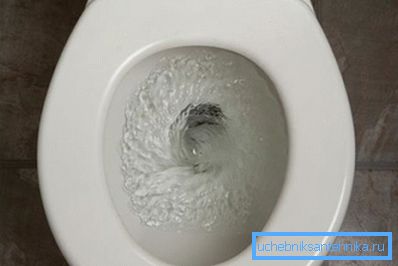
What determines the quality of the drain
To determine which is better to flush the toilet, you must familiarize yourself with all the design features of the sanitary device, which include:
- Bowl shape;
- Type of drain;
- Type of issue.
Of course, to make a choice in favor of a particular model of equipment, you can consult with the seller-consultant. However, as practice shows, not always sellers can give an exhaustive answer to the question of the buyer. Therefore, below we take a closer look at the various options for equipment design and their effect on the drain system.

Bowl Shape
First of all, the quality of the drain depends on the shape of the bowl, which can be divided into three types:
| With shelf | This form is a classic, moreover, in Soviet times there were only toilet bowls of this type. Their feature, as it is not difficult to guess from the name, is the presence of the shelf, which prevents splash splash during the process of using the device. The disadvantages of this form include the fact that in the process of flushing the shelf is poorly cleaned, as a result of which there is a need for additional cleaning with a toilet brush. |
| Funnel shape | In this case, the drain hole is located in the middle. This form provides a quality wash, however, in the process of use may occur splashes. |
| With sloping rear wall | It is a compromise between the classic version and the cup of a funnel-shaped handicap. When using the device there are no splashes and at the same time the walls of the bowl are well cleaned. It follows that a toilet with an oblique sink is the most preferred. |
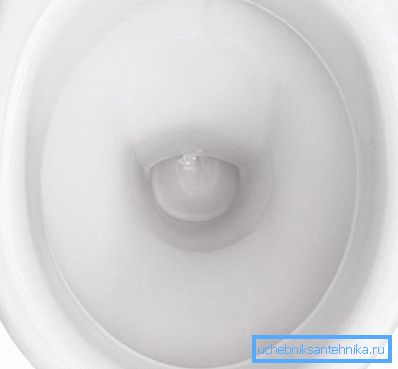
Note! The level of water in the bowl also affects the absence of spatter when using a sanitary device. The lower it is, the better. You can determine the water level in the new device with your own hands even in the store - it corresponds to the level of the lowest outlet point.
Drain type
The quality of the drain also largely depends on the type of its implementation.
Today on sale there are sanitary fittings with three types of sinks:
- Cascade WC - water flow with a powerful pressure flows down the back wall, which is most contaminated, and in this way washes away the contents of the bowl. The disadvantage of this design is that splashes remain on the front wall, which are subsequently cleaned with household chemicals.
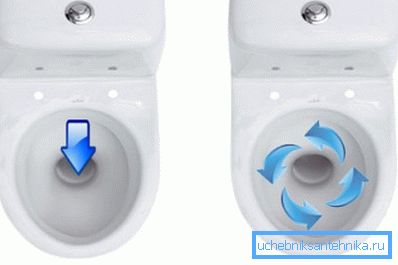
- The toilet with a circular drain or, as it is also called, shower. In this case, water flows are distributed around the perimeter through special channels and evenly clean the walls of the bowl.
I must say that many customers choose toilets so that they can be drained around the circumference. However, experts say that they have no advantages, even despite the even distribution of the flow, as they are worse at cleaning the back wall, which, as mentioned above, is more polluted.
- With suction plum - this system is different from the previous two, since the flush is carried out in a completely different way. This sanitary devices are equipped with a drain valve, which opens when you press the pedal. Therefore, the bowl is first filled with water, after which the contents are drastically drained into the sewer.
A toilet with a pedal sink is considered the most effective in this sense, since the contents of the bowl do not linger on the walls.
Note! When flushing an average of six liters of water is spent. However, there are toilet bowl models that consume less water. This parameter should also be considered when choosing a product.
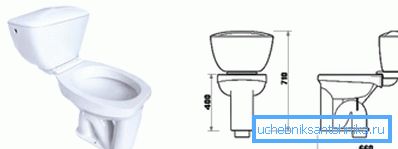
Type of issue
An important point when choosing a toilet bowl is the location of the issue. However, this parameter affects not so much the drain as it does on the installation of the sanitary device. Currently, there are three types of products:
| Horizontal release (straight) | In this case, the outlet is parallel to the floor. If a direct drain is made, the toilet is usually connected in a hidden way, i.e. all communications are hidden behind a false wall. |
| Kosim | The release is inclined to the floor at an angle of 45 degrees. |
| Vertical | The exit is located directly below the toilet. |
In old apartments such as "Khrushchev", as a rule, they installed toilet bowls with oblique release. In modern houses, plumbing with direct release has recently begun to be installed. As for devices with a lower output, they are usually used in private homes and "Stalin".
Tip! If the release of equipment does not coincide with the socket of the sewer pipe, use a special flexible drain for a corrugated toilet bowl.
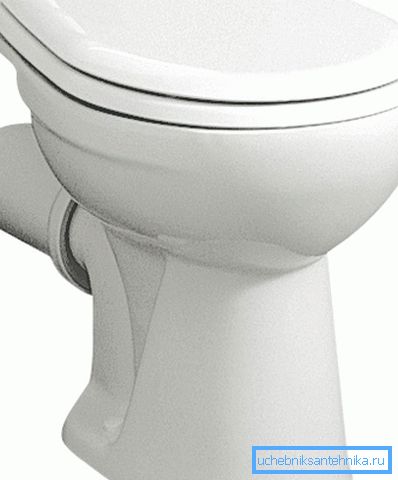
Tank and drain fittings
In addition to the design of the sanitary device itself, a tank, which, as a rule, comes complete with a toilet bowl, and a drain mechanism (fittings) are of great importance for flushing.
All existing types of tanks can be divided into two types:
- Open - are in plain sight.
- Hidden - embedded in a wall or placed in an installation (steel structure), which is hidden behind a false wall. Externally, these tanks resemble a plastic canister, however, in principle they do not differ from the traditional ones. I must say that embedded plumbing more attractive looks, however, its price is higher.
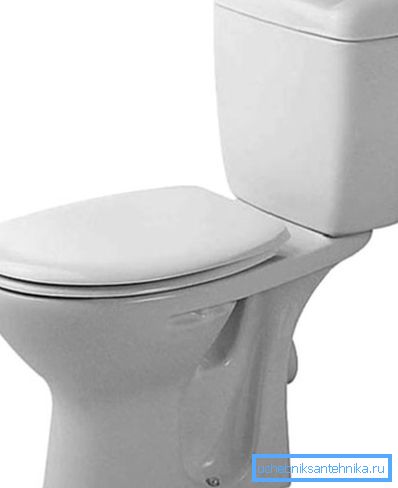
Open tanks are divided into two types:
- Suspended - suspended at a certain height and connected to the toilet using a pipe. With this design, the water enters the bowl with a large pressure, respectively, the quality of the flush increases.
- Mounted on the shelf of the toilet - connect to the toilet directly with a rubber seal without a pipe or other connecting elements.
As for reinforcement, there are quite a few varieties of mechanisms, but they all work on the same principle - the outlet of the container closes the valve, which opens when the button is pressed or when the lever is lifted.
It should be noted that recently a system has been installed in the tanks, which provides a double flush toilet bowl. It is realized with the help of two buttons on the tank - pressing one of them ensures the complete emptying of the contents of the tank, while the second button allows you to flush with a dosed portion of water.

Note! After installing the drain valve you will need to configure the float. Information on how this is done, contains the instruction, which is attached with the mechanism. From this procedure depends on the water flow when draining.
Thus, the toilet with two modes of drainage provides water savings. Moreover, the most advanced models are equipped with several buttons that allow you to control different modes of operation of the system.
Here, perhaps, and all the options of the toilet to the sink, having familiarized with which, you can choose the most optimal model of sanitary equipment.
Conclusion
We considered all the options for drainage, which are found in modern toilets. From the choice of design for this parameter will depend not only the ease of operation of the sanitary device and its comfort, but also cost. Therefore, he should pay attention to no less than the design of the product.
From the video in this article, you can learn more about this topic.